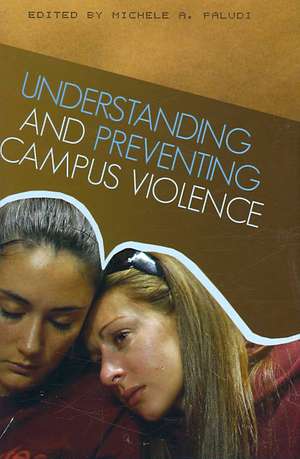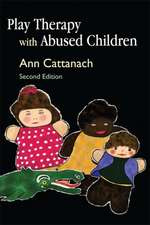Understanding and Preventing Campus Violence
Editat de Michele A. Paludien Limba Engleză Hardback – 29 apr 2008 – vârsta până la 17 ani
Preț: 309.84 lei
Preț vechi: 376.04 lei
-18% Nou
Puncte Express: 465
Preț estimativ în valută:
59.29€ • 64.39$ • 49.81£
59.29€ • 64.39$ • 49.81£
Carte disponibilă
Livrare economică 02-16 aprilie
Preluare comenzi: 021 569.72.76
Specificații
ISBN-13: 9780313348280
ISBN-10: 0313348286
Pagini: 280
Dimensiuni: 156 x 235 x 26 mm
Greutate: 0.59 kg
Editura: Bloomsbury Publishing
Colecția Praeger
Locul publicării:New York, United States
ISBN-10: 0313348286
Pagini: 280
Dimensiuni: 156 x 235 x 26 mm
Greutate: 0.59 kg
Editura: Bloomsbury Publishing
Colecția Praeger
Locul publicării:New York, United States
Notă biografică
Michele A. Paludi is president of Human Resources Management Solutions and participating faculty at Union Graduate College, Schenectady, NY. Paludi is series editor for Praeger's Women's Psychology and Women and Careers in Management and has authored or edited 38 texts on workplace discrimination, sexual harassment, psychology of women, workplace violence, and campus violence. Her book Ivory Power: Sexual Harassment on Campus received the 1992 Myers Center Award for Outstanding Titles in Human Rights. She was recently named "Woman of the Year" by the Schenectady Business & Professional Women's club and is currently the Elihu Root Peace Fund Professor in Women's Studies at Hamilton College, Clinton, NY.
Cuprins
IntroductionAcknowledgmentsChapter One-Gendered Violence on Campus: Unpacking Bullying, Harassment, and Stalking-Jennifer L. MartinChapter Two-Bullying and Hazing: A Form of Campus Harassment-Florence L. Denmark, Maria D. Klara, and Erika M.BaronChapter Three-Shots Heard Round the World: Campus Violenceand International Student Concerns-Presha E. Neidermeyer and Siri TerjesenChapter Four-The Impact of Campus Violence on College Students-Bethany L. Waits and Paula Lundberg-LoveChapter Five-Anti-Violence Pedagogy: Strategies and Resources-Jennifer L. MartinChapter Six-A Is for Activism: Classroom-Based Approaches to Preventing Campus Violence-Joan C. Chrisler and Mab SegrestChapter Seven-Stalking as a Form of Campus Violence: Case Studies-Janet SigalChapter Eight-The Psychology of Women Course as a Catalystfor Change for Campus Violence-Michele Paludi, Florence L. Denmark, and Darlene C. DeFourChapter Nine-Laws Affecting Postsecondary InstitutionsEfforts to Prevent, Respond to, and Recover from Acts of Violence on Campus-Linda Gordon HowardChapter Ten-Sexual Harassment Education-Amy J. RamsonChapter Eleven-Sample Policies and Procedures for Preventingand Dealing with Campus Violence-Michele Paludi, Carmen Paludi, Jr., and Maritza SantosChapter Twelve-Security on Campus: Our Mission Is Safer-Campuses for Students-Jonathan M. KassaChapter Thirteen-College Campus Violence Prevention: HowBackground Investigations Can Have a Direct Impact-Mario Pecoraro, Jr.Chapter Fourteen-Responding to Sexually Victimized CollegeStudents-Connie Kirkland and Howard KallemAppendices-Dealing with and Preventing Campus Violence: Resources for Administrators, Students, Employees and FacultyAppendix A-Advocacy Resources Dealing with Campus Violence-Michele Paludi and Christa WhiteAppendix B-Campus Wide Educational Techniques-Betty Jean Uebrick, Gennette Hollander, Carrie Turco, Christa White, and Michele PaludiAppendix C-Campus Security Recommendations for Administrators to Help Prevent and Deal with Violence-Jesse Middelkoop, John Gilhooley, Nicholas Ruepp, Raymond Polikoski, and Michele PaludiAppendix D-Keeping Safe on College Campuses: Recommendations for Students-Michele PaludiIndexAbout the EditorAbout the Contributors
Recenzii
The recent episodes of campus violence in the US have received much media attention and have permanently etched in the minds of millions of Americans fear that campuses, once thought to be safe, are no longer havens from violence. In this timely volume, editor Paludi brings together a multidisciplinary group of contributors to codify and make orderly sense of the research on campus violence; demonstrate the importance of and methods to communicate with the campus community on this issue; and advise on dealing with and preventing campus violence. There is so much valuable information contained in these pages it is difficult to point to a single idea. Perhaps at the top of this reviewer's list would be the excellent discussion of institutional policy and policy implementation. The materials presented in the text are well documented, the arguments are thorough, and the editor's message is clear--campuses need to come to grips with violence of all sorts..Paludi's volume is practically required reading for higher education administrators, campus leadership across the board, and those seeking answers to violence in general. Highly recommended. All academic collections.
I think that this book would appeal best and be most helpful to student affairs personnel charged with the general well-being and cocurricula development of students rather than to specialists in college mental health, law, or security. It might also be appropriate for graduate courses in student personnel administration and higher education administration, but I do not think it would be a useful text for undergraduate or graduate courses in psychology. In sum, I would recommend it for those new to the problem of violence on campus and to those with broad rather than specialized administrative responsibilities on campus.
The broad reach of this book makes it a good resource for those affiliated with college campuses.this book is very accessible to a wide audience. It moves beyond the coverage of theory and statistics to the provision of sensible and specific recommendations, which will make it a useful tool for any who work with college students.
I think that this book would appeal best and be most helpful to student affairs personnel charged with the general well-being and cocurricula development of students rather than to specialists in college mental health, law, or security. It might also be appropriate for graduate courses in student personnel administration and higher education administration, but I do not think it would be a useful text for undergraduate or graduate courses in psychology. In sum, I would recommend it for those new to the problem of violence on campus and to those with broad rather than specialized administrative responsibilities on campus.
The broad reach of this book makes it a good resource for those affiliated with college campuses.this book is very accessible to a wide audience. It moves beyond the coverage of theory and statistics to the provision of sensible and specific recommendations, which will make it a useful tool for any who work with college students.















